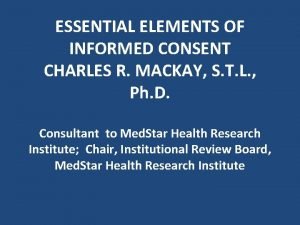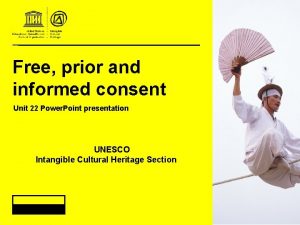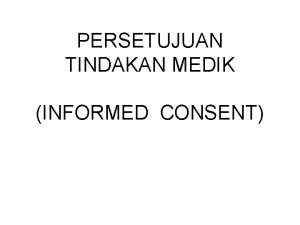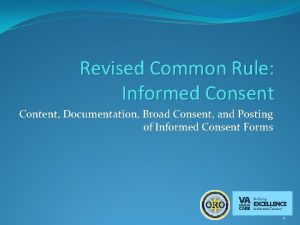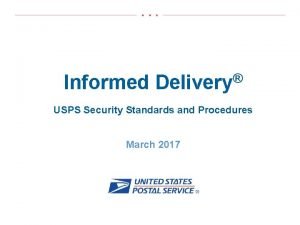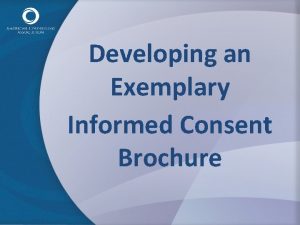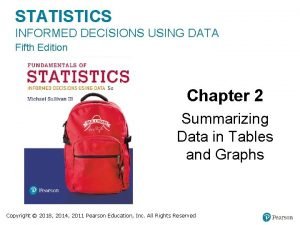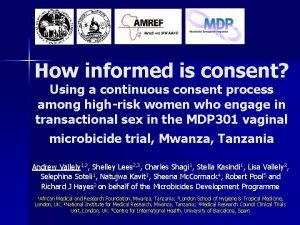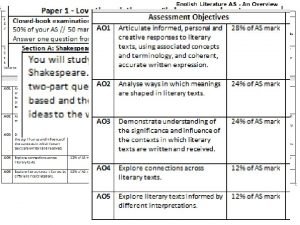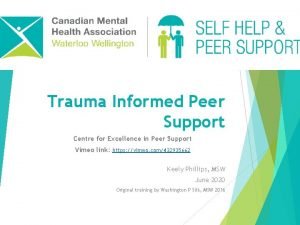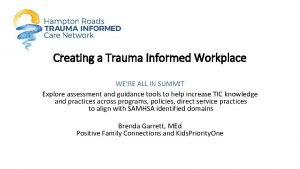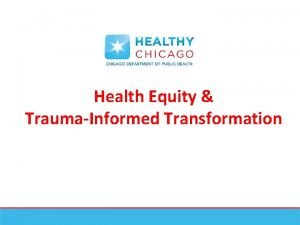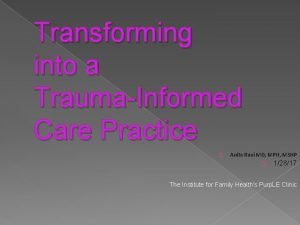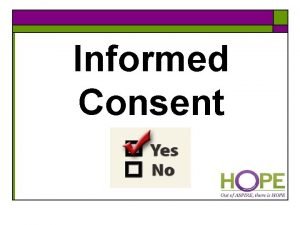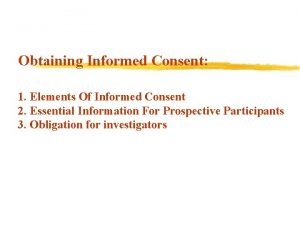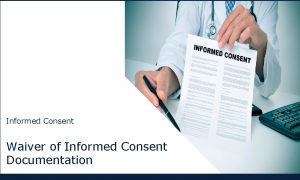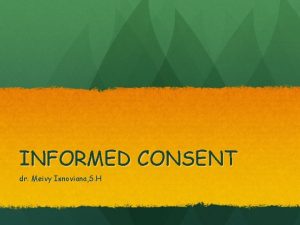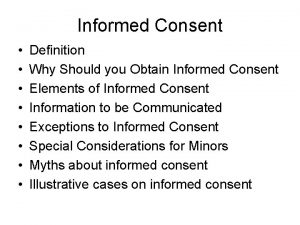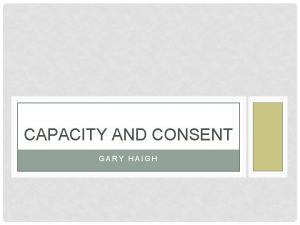How informed is consent Using a continuous consent



















- Slides: 19

How informed is consent? Using a continuous consent process among high-risk women who engage in transactional sex in the MDP 301 vaginal microbicide trial, Mwanza, Tanzania Andrew Vallely 1, 2, Shelley Lees 2, 3, Charles Shagi 1, Stella Kasindi 1, Lisa Vallely 3, Selephina Soteli 1, Natujwa Kavit 1, Sheena Mc. Cormack 4, Robert Pool 5 and Richard J Hayes 2 on behalf of the Microbicides Development Programme 1 African Medical and Research Foundation, Mwanza, Tanzania; 2 London School of Hygiene & Tropical Medicine, London, UK; 3 National Institute for Medical Research, Mwanza, Tanzania; 4 Medical Research Council Clinical Trials Unit, London, UK; 5 Centre for International Health, University of Barcelona, Spain

Objectives n To understand the effectiveness of locally-appropriate procedures for obtaining informed consent in the MDP 301 phase III vaginal microbicide trial in Tanzania.

Study population n An occupational cohort of women who work in bars, restaurants, guesthouses and other food outlets and recreational facilities in Mwanza City, northern Tanzania

Grocery (left) and modern bar (right), Mwanza

Traditional bar (kilabu), Mwanza

Restaurant, Mwanza

Feasibility Study n n n 1573 participants enrolled and FU for up to 18 months; study ran from Jul 02 -Mar 05 High baseline prevalances of HIV, STIs and vaginal infections (e. g. HIV 26%; HSV-2 75%; BV 53%); HIV incidence 3. 5/100 PYs Poor education levels and high rates of illiteracy observed (e. g. 24% did not complete primary education) Ref: Vallely A et al; Sex Trans Dis 2007; [E-pub ahead of print]

Continuous consent Experience during feasibility led to reappraisal of informed consent procedures in consultation with community stakeholders n ‘Continuous consent’ combines community and clinic-based components n Consent seen as a process from first contact in the community to final visit in the clinic rather than a point activity at study entry n

Facility-based mobilisation

Screening & Enrolment Flipchart (groups) n Information Sheet n Comprehension Checklist n Informed Consent Forms n Audio-cassette and pictorial directions on gel use (enrolment) n

Follow-up visits n Audio cassette at any clinic visit as indicated / requested by ppt n Comprehension checklist at 12, 24, 40, 52 wk clinic visits

How effective is this approach? n In order to understand how well women internalize and retain key messages, in-depth interviews (IDIs) are being carried out in a random sample immediately after their 4, 24 and 52 wk follow-up visits

Results n To date (end-Jun 07) 104 women have completed IDIs (67 x 4 wk; 30 x 24 wk; 7 x 52 wk) n In all interviews there was evidence of good comprehension and retention of key messages e. g. – why is the trial being carried out? – does the gel protect against HIV?

Why is the trial being carried out? All of the 104 women interviewed had at least a basic understanding of why the trial was being conducted "They are trying the gel so that they may be sure if it will help to prevent infections of HIV/AIDS so that people could start using it. “ “When we went to the clinic they told us that there were two types of gel, there is a gel with medicine and a gel without medicine, now for us that use the gel we do not know if it has medicine or not. ”

Does the gel protect against HIV? 81/104 (78%) said that the gel did not protect against HIV “At present I do not know… until after the results are examined by those experts, they will know and will inform us. But I am hopeful that it [gel] can help. ”

23/104 (22%) were ‘unsure’ if the gel might be working, reasoning that the trial is on-going “I can’t trust it [the gel] so much since its still on trial” “I am not sure with gel because we haven’t reached the end of the study, we don’t know yet if it protects or not. ” “I am not sure [gel works] because it’s on trial…that’s why I use condoms. "

Some women in both groups also commented on the gel perhaps having indirect protective effects “I think the gel can protect against infections, maybe…it can even protect against other infections because you don’t get bruises. ” “That lubricant [gel] can protect against HIV/AIDS infection because you don’t get bruises… they say that this gel doesn’t have medicine…but that lubricant can prevent you from getting bruises. ”

Conclusions n. Providing information to trial participants in a: – focussed, locally-appropriate manner; – using methods developed in consultation with the community; and – within a continuous informed-consent framework …resulted in high levels of comprehension and message retention in this setting n This approach may represent a model for researchers conducting HIV prevention trials among other vulnerable high-risk groups

Acknowledgements Our special thanks go to the women who participated in the feasibility study in Mwanza and those who are currently participating in the MDP 301 trial We would also like to acknowledge the contribution and support of the following: n n Community Advisory Committee (CAC), MDP Mwanza Stakeholders Advisory Group (SAG), MDP Mwanza African Medical & Research Foundation (AMREF) MWAMKO clinical and community teams National Institute for Medical Research (NIMR) Mwanza laboratory, social science, data entry, pharmacy teams
 Ethical principles governing informed consent process
Ethical principles governing informed consent process Essential elements of informed consent
Essential elements of informed consent Free prior and informed consent
Free prior and informed consent Advantages of informed consent
Advantages of informed consent Dasar hukum informed consent
Dasar hukum informed consent Broad informed consent
Broad informed consent Http informed delivery usps
Http informed delivery usps Informed consent brochure
Informed consent brochure Statistics informed decisions using data 5th edition pdf
Statistics informed decisions using data 5th edition pdf Continuous consent
Continuous consent Longer action in progress now example
Longer action in progress now example Past simple future simple present simple
Past simple future simple present simple 8 puzzle python
8 puzzle python Informed personal response
Informed personal response Psychologically informed environments
Psychologically informed environments Kobtion
Kobtion Trauma informed workplace
Trauma informed workplace Trauma informed practice
Trauma informed practice Anita ravi md
Anita ravi md Decision making skills
Decision making skills

